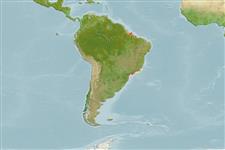Environment: milieu / climate zone / depth range / distribution range
Ecology
Marine; brackish; pelagic-neritic; depth range 1 - 22 m (Ref. 189). Tropical; 1°N - 27°S, 51°W - 32°W (Ref. 189)
Southwest Atlantic: mouth of Para River southward to Cananéia, Brazil.
Size / Weight / Age
Maturity: Lm ? range ? - ? cm
Max length : 6.8 cm SL male/unsexed; (Ref. 189)
Short description
Identification keys | Morphology | Morphometrics
Dorsal spines (total): 0; Anal spines: 0; Anal soft rays: 22 - 25. Snout short, about 1/2 eye diameter; maxilla shorter than in most other Anchoa species, tip pointed, not reaching beyond hind margin of pre-operculum; gill cover canals of walkeri-type. Pectoral fins large, reaching about pelvic fin origin; anal fin fairly long, its origin below or just before midpoint of dorsal fin base. A silver stripe along flank, less than eye diameter.
Presumably schooling along beaches and down to 22 m. A single specimen was recorded from Coqueiros at the mouth of the Paraguaçu River, thus able to tolerate lowered salinities. More data needed.
Life cycle and mating behavior
Maturity | Reproduction | Spawning | Eggs | Fecundity | Larvae
Spawn in school (Ref. 205).
Whitehead, P.J.P., G.J. Nelson and T. Wongratana, 1988. FAO Species Catalogue. Vol. 7. Clupeoid fishes of the world (Suborder Clupeoidei). An annotated and illustrated catalogue of the herrings, sardines, pilchards, sprats, shads, anchovies and wolf-herrings. FAO Fish. Synop. 125(7/2):305-579. Rome: FAO. (Ref. 189)
IUCN Red List Status (Ref. 130435: Version 2024-2)
Threat to humans
Harmless
Human uses
Fisheries: of no interest
Tools
Special reports
Download XML
Internet sources
Estimates based on models
Preferred temperature (Ref.
123201): 22.5 - 28.2, mean 27.3 °C (based on 81 cells).
Phylogenetic diversity index (Ref.
82804): PD
50 = 0.5000 [Uniqueness, from 0.5 = low to 2.0 = high].
Bayesian length-weight: a=0.00513 (0.00234 - 0.01125), b=3.14 (2.97 - 3.31), in cm total length, based on LWR estimates for this Genus-body shape (Ref.
93245).
Trophic level (Ref.
69278): 3.3 ±0.4 se; based on size and trophs of closest relatives
Resilience (Ref.
120179): High, minimum population doubling time less than 15 months (Preliminary K or Fecundity.).
Fishing Vulnerability (Ref.
59153): Low vulnerability (10 of 100).
Nutrients (Ref.
124155): Calcium = 544 [282, 1,400] mg/100g; Iron = 2.63 [1.41, 4.91] mg/100g; Protein = 17.1 [14.8, 19.8] %; Omega3 = 0.327 [0.152, 0.686] g/100g; Selenium = 33.6 [14.2, 83.5] μg/100g; VitaminA = 34.9 [10.4, 96.6] μg/100g; Zinc = 2.93 [1.91, 4.41] mg/100g (wet weight);
